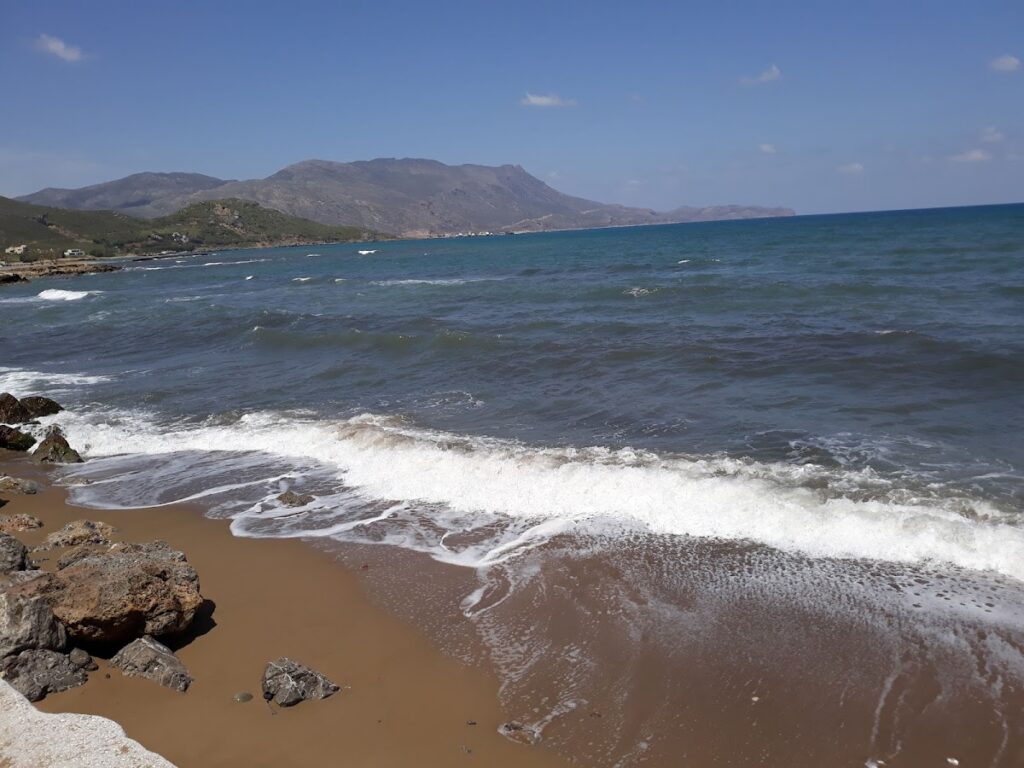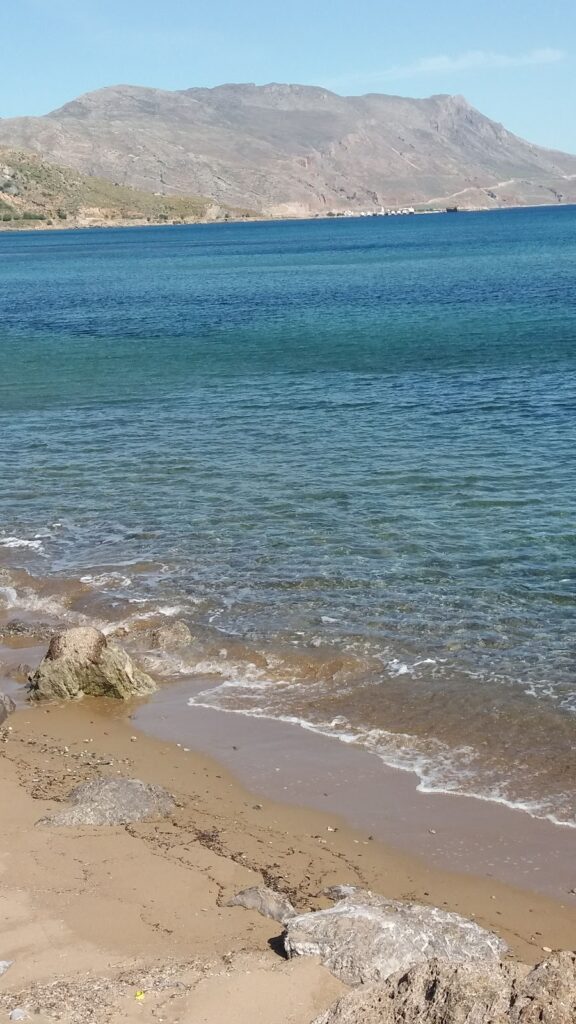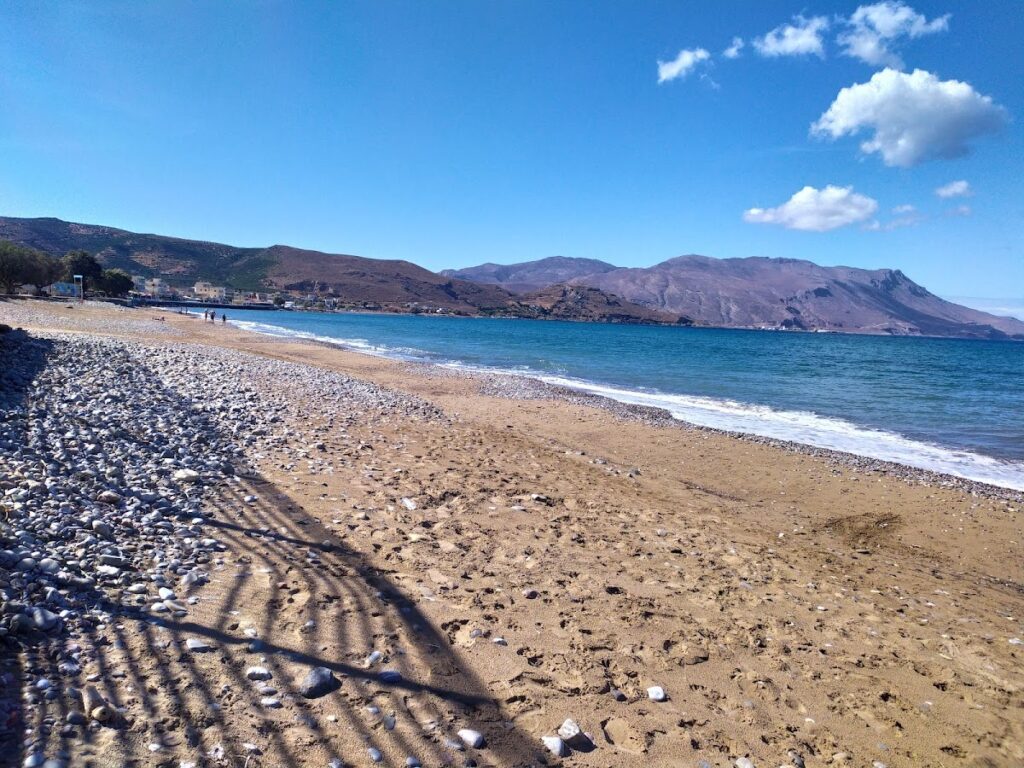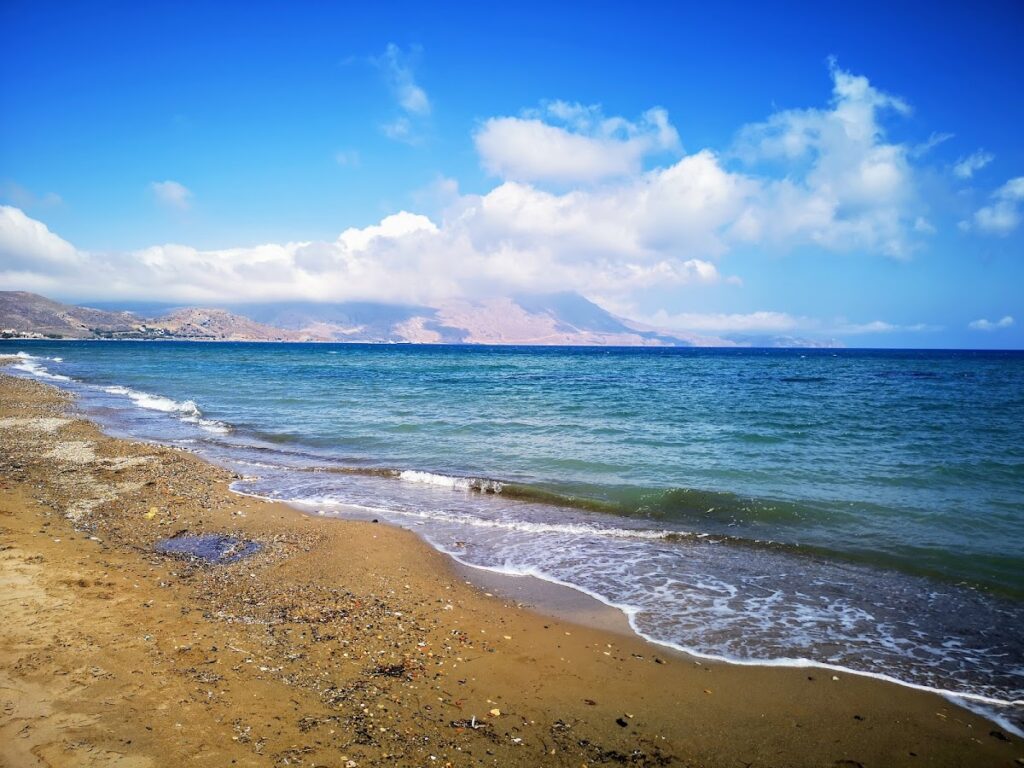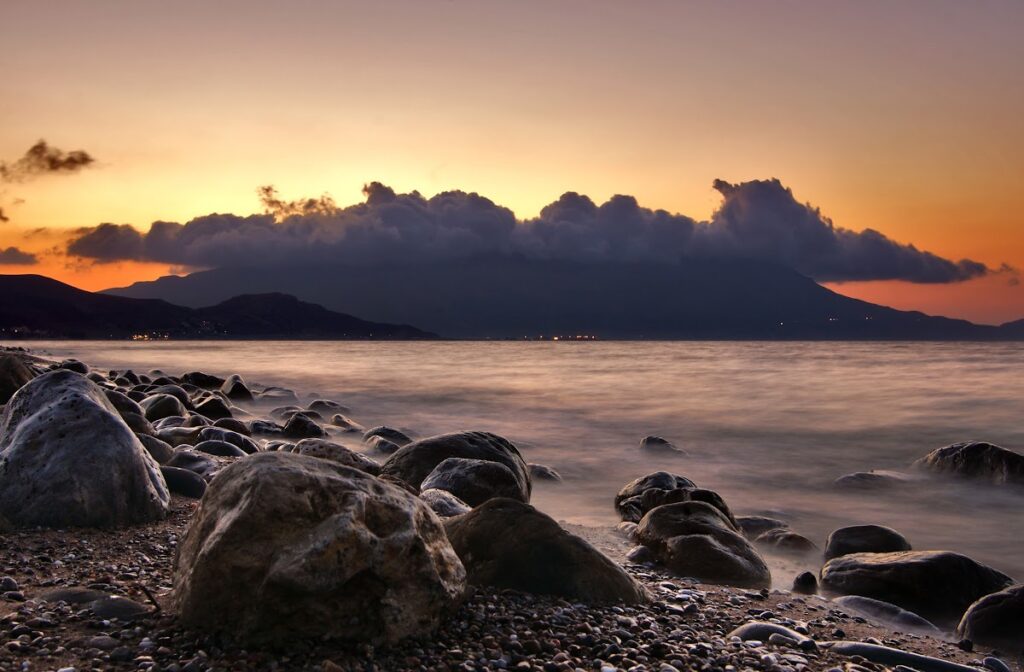Beaches near Kounoupítsa, in Chania region
Here is list of closest beaches to Kounoupítsa
- 2.0 km
- Telonio beach
- Sand
- Shallow
- Blue
Telonio Beach, beginning east of Kissamos’ main pedestrian road and extending to the Kissamikos stadium approximately 1km east, is the most westerly section of a long stretch of beach that reaches from Kissamos to Nopigia. Telonio is situated adjacent to Kissamos’ most vibrant area, where the former Customs’ Office and the current bustling seaside pedestrian road with its numerous taverns and cafes can be found. The beach itself is a mix of pebbles and sand, often characterized by waves and shallow water. Despite being close to the town, it is typically unorganized. Telonio used to be the most frequented beach in the area decades ago, but now Mavlos Molos holds that title. Telonio remains an excellent choice for those who desire tranquility yet also want the convenience of nearby amenities.
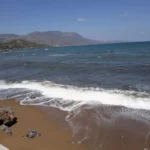
- 2.3 km
- Mavros Molos beach
- Sand
- Shallow
- Blue
Situated directly in front of the town of Kissamos, and 36km west of Chania, you’ll find Mavros Molos beach, also known as the ‘black jetty’. This long bay is historically significant, with remnants of the ancient port of Kissamos discovered here. As the primary beach of Kissamos town, it attracts the highest number of swimmers in the region. Its fine sand and shallow waters make it an ideal spot for families and children. Adjacent to the beach, a variety of cafes, restaurants and hotels can be found. Facilities such as umbrellas, sunbeds, lifeguard services and showers are available for beachgoers. Additionally, tamarisk trees offer natural shade.
To the west of the main beach, Mavros Molo’s features a smaller, pebbly and rocky cove. This secluded spot rarely gets crowded, making it perfect for snorkelling.
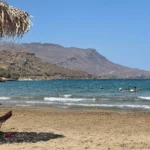
- 2.4 km
- Livadia beach, Kissamos
- Pebbles, Sand
- Shallow
- Blue
The Livadia beach, commencing 1km east of the Kissamos stadium and concluding at Korfalonas beach, is a small 2km stretch of the extensive beach that originates from Kissamos and finishes at Nopigia in the Rodopos Peninsula. The beach, like its neighbours, is characterized by its sandy terrain with occasional pebbles. It is exposed to the wind, making the water typically shallow and wavy.
Despite being not highly organized, it features several spots with umbrellas, small hotels, and restaurants. Its expansive length gives an impression of emptiness. On calm days, it is an ideal choice for those seeking a tranquil spot to swim yet remaining in proximity to urban conveniences.
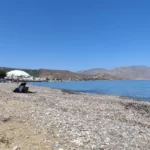
- 3.1 km
- Korfalonas beach
- Pebbles, Sand
- Shallow
- Blue
Korfalonas beach, nestled between Livadia and Drapanias beaches, is situated 4.5km to the east of Kissamos and 32km to the west of Chania city. The beach takes its name from a nearby settlement of the same name, found a few kilometres to the south of the beach.
The beach of Korfalonas is characterized by its long stretch of sandy shore and shallow waters, forming a central part of the extensive beach that extends from Kissamos to Cape Rodopos. Despite its seclusion, it offers basic amenities such as umbrellas, showers, and nearby taverns and hotels.
Korfalonas is a perfect destination for those seeking a tranquil vacation, with its essential facilities close at hand. Adjacent to the beach, visitors may observe some deserted factories and antiquated buildings.

- 3.7 km
- Damialis beach
- Fine Pebbles, Pebbles
- Deep
- Deep blue
Damialis beach, situated 37km west of Chania and a short 1.5km north of Kissamos, can be easily accessed via the main road that connects Kissamos to Falassarna. This petite cove boasts pristine deep waters, eye-catching rocks, and tiny pebbles, all while being well-shielded from strong winds. Though the beach is not equipped with facilities, visitors can seek shade under the tamarisk trees. A springboard on the rocks also adds to the charm of the beach.
The beach derives its name from the picturesque St. John Damialis church, nestled inside a cave above the beach. A brief path from the church crosses the road via a small tunnel, leading straight to the beautiful beach.
A mere 200m south of Damialis, one can discover the three to four small coves of Delfini, or Dolphin, named after a local hotel. These secluded beaches are tranquil, though occasionally, streams may deposit rubbish on the shores.

- 4.2 km
- Vigglia beach
- Sand
- Normal
- Blue
Located 3km northwest of Kissamos town and 38km west of Chania, you’ll find the beach of Vigglia on Crete island. This beach begins near the “Madonna of the Harbor” church (Panagia) by the port of Kissamos, stretching along a 2km coastline featuring many coves, all the way to Kaliviani to the west. Notably, Vigglia’s primary beach boasts a nearly semicircular shape, with its coarse sand and transparent water. There are areas where the sandy beach is replaced with pebbles and rocks.
Although Vigglia doesn’t provide extensive tourist services, there are a few hotels in its vicinity and some basic facilities. Despite not being highly organized, Vigglia attracts many admirers who appreciate the area’s tranquillity and pristine sea. If you’re seeking a family-friendly destination in western Crete, Vigglia would be an excellent recommendation.
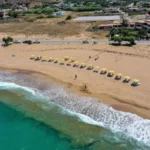
- 5.0 km
- Drapanias beach
- Pebbles, Sand
- Shallow
- Blue
Drapanias Beach, situated 5km east of Kissamos and 32km west of Chania, lies between the beaches of Korfalonas and Nopigia. It takes its name from the eponymous village located approximately 1km south of the beach. The eastern part of the beach is also known as Kokkino Metohi, named after a nearby small village whose inhabitants own the surrounding land.
Stretching over a long area of 2km, Drapanias Beach is part of a large beach that extends from Kissamos to Cape Rodopos in the east. Like its neighbouring beaches, it is sandy and shallow but is often wavy due to the northern winds.
The shoreline of Drapanias is dotted with restaurants, cafes and lodgings. It also offers amenities such as umbrellas and showers. Additionally, there are two camping sites located in Drapanias.
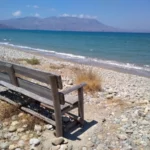
- 5.5 km
- Kaliviani beach
- Rocks in places
- Normal
- Blue
Kalyviani Beach, situated a mere 1km north of the eponymous traditional village at the foot of the Gramvousa Peninsula and 7km northwest of the town of Kissamos, is a lengthy stretch of coast that serves as a viable option for swimming for those visiting the scenic village of Kaliviani. However, its overall rocky terrain with sparse sandy patches doesn’t make it a favourite among swimmers. It is advised to avoid the beach during gusty days, as the large waves coupled with the rocky seabed can make swimming hazardous.
Despite its proximity to Kissamos and Kaliviani village, where accommodation and dining options are available, the beach lacks tourist facilities. It also tends to be less than pristine, as it often becomes a depository for trash brought in by the currents and waves.

- 6.3 km
- Nopigia beach
- Pebbles, Rocks in places
- Normal
- Blue
Nopigia, a coastal village, is situated 6km east of Kissamos and 30km west of the city of Chania. Nestled on the eastern side of Kissamos Bay, it sits adjacent to the base of Rodopos Cape and follows the eastern end of Drapanias beach.
A long beach lies ahead of the village, stretching westwards up to Kissamos. The beach boasts sandy shores with clear, shallow waters. As Nopigia village is close by, visitors can easily access facilities like umbrellas, showers, restaurants and accommodation, all set in a peaceful environment.
To the east, the beach becomes rockier and more secluded, presenting several pebbly and rocky coves. After walking 2km, you will come across the church of Panagia and the beautiful remote beaches of Choni.
Nopigia is believed to have a history dating back to ancient times. Local folklore suggests that upon Agamemnon’s return from Troy, he landed in the area to give offerings to the gods. However, he had to leave swiftly due to the Trojan prisoners’ attempt to burn his fleet.
Not far from Nopigia, following the road to Koleni, you’ll find the ruins of the ancient town Mythimna, nestled amidst olive groves. You can also visit the cruciform Church of St. Panteleimon, which features a cylindrical dome and rectangular floor layout. To the west of Nopigia, ruins of a Roman settlement and a church adorned with Byzantine frescoes, dedicated to Saint George, can be found. Interestingly, the church’s orientation is from North to South, unlike the typical Greek Orthodox churches that face from East to West. This is believed to be due to its construction on the site of an earlier Roman temple, the direction of which was preserved. To the east of Nopigia, there is a small seaside theatre, built in 1992, modeled after ancient Greek theatres and renowned for its excellent acoustics. Lastly, just 200m off the main village street, you can explore the cave of Rizospilios, an underground river.

- 6.5 km
- Meri Pigadi beach
- Pebbles, Rocks in places
- Normal
- Blue
Tou Meri to Pigadi is located 8km northwest of Kissamos and 44km west of Chania, on the eastern side of Peninsula Gramvousa. The name means “Meri’s well”, probably named after the name of someone, who owned a well in the area. Meri Pigadi has three consecutive small protected bays, with fine pebbles and crystal clear deep waters. There are no facilities on the beaches; it is an ideal place to relax, away from the noise of cities.
There are a few small trees, under which you can find shade. The first bay, just behind the ticket kiosk of Balos lagoon, is called Mouri Lakkos. To get to Meri’s Well, you have to walk or drive 1.5km into the dirt road that starts from Kaliviani and leads to the lagoon of Balos. If you visit the beaches, do not forget to have water with you.
1.5km north of Meri Pigadi, at position Kakia Skala, there is a small beach with fine pebbles and gorgeous deep blue water, adjacent to the eastern cliffs of the cape. Access to the beach is not easy, as the rocky cliffs make the descent impossible.

No results available
ResetBeaches in other nearby areas
No results available
Reset